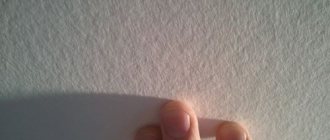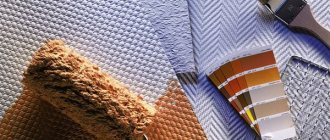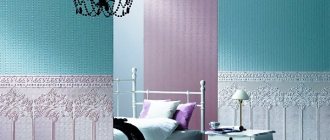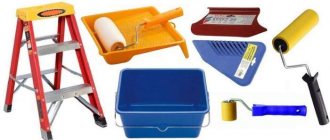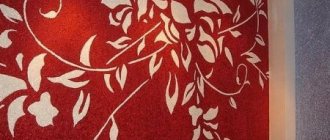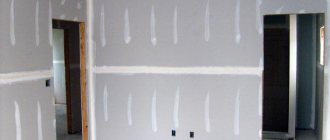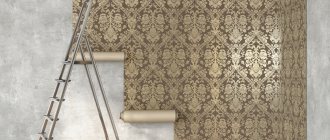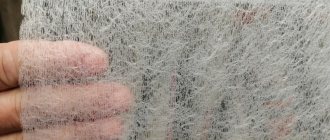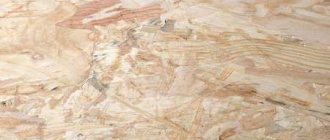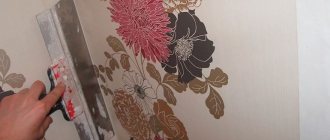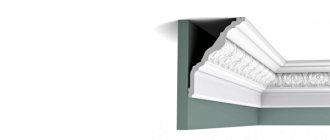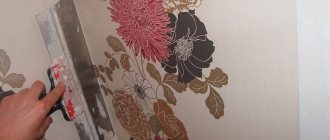Today, glass wallpaper is used in many industries as a durable, wear-resistant, as well as aesthetic finishing material. The functionality of these wallpapers allows them to be used as a decorative finish on almost any surface. They are used in gluing the surfaces of office and residential premises, in finishing the ceiling, as well as various stoves. Of particular interest are glass wallpapers for finishing furnaces, which are characterized by fire safety and environmental friendliness, since when heated they practically do not emit any toxic substances.
Only natural materials are used in the production of glass wallpaper. They are made from special glass fiber, which under pressure and high temperature (1000-1200 C) takes the form of yarn of different thicknesses. Ready-made materials are used to make spider webs. The latter has the shape of a web and “reinforces” the glass wallpaper. Glass wallpaper for stoves is advantageous because it does not require unnecessary processing and transmits heat very well. Also, glass wallpaper can be painted with detergent paints and water-based paints. If we add high strength and heat resistance to these characteristics, we get a finishing material that has no analogues in its properties.
Finishing a stove with glass wallpaper is a targeted and step-by-step process in which glass wallpaper is correctly adhered to the surface of the stoves. Many people are afraid that when covering the furnace with glass fibers, the latter will burst or will not allow sufficient heat to pass through. However, in practice it is proven that they can be guaranteed to be used in oven finishing. They are also used along with other finishing materials.
Pros and cons of glass wallpaper
Like any other wallpaper, glass wallpaper has its advantages.
- Durability. Service life - more than 30 years.
- Environmental friendliness. The wallpaper contains 100% environmentally friendly ingredients: soda, lime, dolomite and quartz sand, and mold and mildew do not form under them.
- Density. Under such wallpaper you can hide any uneven surface, and besides, it is difficult to tear it.
- Versatility. Manufacturers strive to diversify their products. Therefore, they produce colored and plain rolls suitable for both painting and direct gluing.
- Antistatic effect. Fiberglass wallpaper does not attract dirt and dust.
- Resistant to repeated painting. Wallpaper can withstand up to 20 paintings.
- Waterproof. They do not allow water to pass through in wet rooms and serve as a good alternative to tiles.
Main types of invoices
- The diamond is a classic image.
- Herringbone - used in rooms where the pattern is not particularly important.
- Cobweb - for the ceiling, good for leveling.
- Matting is the best option for decorating indoor walls.
Advantages
Consider a wallpaper option that is highly durable. Experts also differentiate by design in their works.
- Environmentally friendly material.
- Long service life.
- UV resistance.
- Water resistance.
- Can be used in rooms with a lot of moisture.
- Lets air through.
- Dust does not accumulate on them.
- Painting glass wallpaper is not difficult.
- Can be used in the design of a children's room, as the materials are non-allergenic.
- Fire resistant.
If there is a fire in the building, no toxic impurities are released. Experts recommend using glass wallpaper in corridors.
Flaws
They are not that significant, but you need to get acquainted with them before purchasing. It is advisable to buy from trusted stores.
Buying wallpaper that does not meet the requirements may result in unpleasant situations in the future.
- Dismantling them is not so easy.
- The cost is high.
- Poor quality wallpaper may lose its texture during painting.
- During installation work, protective equipment should be used.
- To apply pasting, you need to level the surface of the wall.
Disadvantages of glass wallpaper
- Difficult to remove from walls. If you have a desire to change the glass wallpaper, then removing the old ones will be problematic. Therefore, it is better to consciously choose the wallpaper you really like for painting once and change its color as desired.
- High paint consumption. If you choose white wallpaper to be painted rather than with color applied, then you will need a sufficient amount of paint to obtain an intense color, since the porous surface absorbs a lot of paint.
- The texture of the wallpaper is reduced. If you repaint the wallpaper several times, then by the 15th layer all the texture of the wallpaper will not be noticeable at all.
- High price. Due to the complex technological process, this type of wallpaper is expensive.
Preparing the oven
1. The whitewash layer must be removed, not because of the characteristics of the wallpaper itself, but because any glue, impregnating the whitewash, makes it heavier and denser. Because of this, the connection between it and the surface covered with it is lost. Gluing any material to whitewash will lead to failure.
2. Sealing cracks and microcracks with oven mixture.
3. Leveling the oven surface.
Before wallpapering, all layers of preliminary preparation must be completely dry.
How to choose glass wallpaper?
When choosing glass wallpaper, you should be guided by the following 3 rules:
- amount of fiberglass. The combination of 70% fiber and 30% impregnation is considered the most advantageous;
- deep relief. The more pronounced the relief of the wallpaper, the less likely it is to smooth out after several paintings; moreover, such wallpaper requires more glue and paint;
- quality of weaving. If you look closely at the surface of the wallpaper, you will notice its fibers, which should be dense, even and smooth; otherwise, you should not take the product, since the first time you paint it, the entire pattern will disappear.
In addition, pay special attention to the edges of the wallpaper in the package. They should be even and smooth, and not shaggy, since the wallpaper itself is woven from fibers.
On the back side of the panel there must be a stripe, thanks to which you can distinguish the front side from the back side, and not confuse the wallpaper pattern. There are also defects on the surface of the wallpaper - this is a technical error, which is compensated by increasing the area of the canvas.
Ways to increase fire resistance
To increase the fire resistance of walls and other structures in the house, they are coated with non-flammable substances, and fire-resistant materials are used for finishing. Products consisting entirely of inorganic substances or their predominant amount are known to be the most heat-resistant. Some mineral reagents are used as fire retardants.
There are a small number of organic compounds that are not flammable and do not support combustion. Some of the non-flammable organic solvents are even used in firefighting.
You can protect walls and structures from fire:
- using heat-resistant primer, pastes, plasters;
- painting walls with fire-resistant paints;
- pasting with heat-resistant wallpaper;
- installing sheets or slabs that do not react to fire;
- impregnating materials with fire retardants.
The decision to choose a fireproof material for walls should be made after assessing financial possibilities and discussing the project with craftsmen and designers. Reasonably chosen non-combustible finishing will help insulate the room and increase sound insulation.
Tools and materials for gluing glass wallpaper
In order to cover a room with glass wallpaper, you need the following tools:
- Primer. This composition is necessary for better adhesion of the wallpaper to the wall surface.
- Rubber roller or spatula. It is necessary for leveling and removing excess air from under the wallpaper.
- Brush for applying glue.
- A knife or scissors to cut off any remaining unnecessary wallpaper residue.
The packaging with glue should indicate how much is needed for wallpapering. If this is not written, then you should focus on the figure of 200 g of ready-made solution per square meter of canvas.
Care Tips
In houses with stove heating, maintaining the stove and fences that protect the combustible structures of the house from overheating in good condition is the key to trouble-free living for its owners. Fire is no joke, and there are no trifles in observing fire safety rules! If they say that a sheet of metal measuring 500x700 mm is needed in front of the furnace loading door, it should be there!
Every year, before the start of the heating season, you should check the condition of the heating appliances at home. It is necessary to check whether the heat-resistant plaster of the stove is damaged, whether there are cracks in the chimney, or whether the facing tiles have fallen off. All identified defects must be corrected in a timely manner.
Fire-resistant panels are an excellent guarantee of the safety of your property.
Where can glass wallpaper be glued?
Fiberglass and glass canvas are used not only in home interiors, but also in public places: offices, shops, kindergartens, restaurants, where there is a crowd of people and maximum impact on the wallpaper. Also, glass wallpaper can be glued on surfaces where there is exposure to heat: stove, kitchen, etc.
How to glue glass wallpaper to a wall?
To prevent the wallpaper from coming off the wall, make sure that there are no drafts in the house and that the penetration of sunlight onto the wallpaper being glued is minimal. In addition, air humidity should not exceed 70%.
I. Preparation of wallpaper.
We cut the wallpaper to the required length in advance. It is advisable to measure each section separately, since often, especially in large-panel houses built in the USSR, the walls are uneven. You will either end up with a cut that is smaller than necessary, or larger than necessary, especially since glass wallpaper is not a cheap material, and throwing out unnecessary remaining pieces once again is the same as throwing money away. If the wallpaper has a pronounced pattern, then it is necessary to adjust it in advance or leave an allowance of such length that the pattern can be matched directly on the wall.
II. Glue preparation.
In addition to the fact that preparing the wall surface for wallpapering is of great importance, it is equally important to choose the right adhesive. Regular glue, which is used for paper and non-woven wallpaper, will not work here. Fiberglass weighs much more than other wallpapers, which means you need an adhesive that will allow the textured canvas to be glued to the wall tightly enough.
Typically, wallpaper manufacturers indicate what kind of glue is needed for certain wallpapers: powder or ready-made, diluted. If glue is sold in powder or cotton wool, then the glue to water ratio is always written on the container with glue for optimal adhesion. It is best to pour the diluted glue into a tray, which will allow you to squeeze out the excess; a budget option is a regular bucket.
III. Gluing process.
First of all, you need to apply glue to the surface of the wall. Or the glue can be applied directly to the wallpaper, having previously coated the wall with glue along the width and length of the wallpaper itself with a margin. The way you glue the first strip of wallpaper, the rest will stick as well. Therefore, you need to be as careful as possible here. After the canvas is applied, you will need to use a rubber roller or spatula, this is necessary to remove unnecessary air from under the wallpaper and excess glue.
The movements should resemble a herringbone pattern as you move from the center to the edges. Do not press too hard with a spatula or roller on the wallpaper, so that the canvas does not tear or move. All wallpaper strips must be glued together, unless otherwise provided by the design.
IV. The final stage of gluing glass wallpaper.
After the wallpaper is hung, you will need to let it dry, there should be no draft in the room, and the air conditioner should also be turned off for a day or two.
How to glue glass wallpaper to the ceiling?
The process of gluing wallpaper on a ceiling is not much different from gluing wallpaper on a wall, with the exception of the geometry of the wall. First of all, apply glue to the ceiling equal to the width and length of the wallpaper strip. Then, we apply the canvas to the ceiling and remove unnecessary air.
How to glue glass wallpaper to a brick oven?
If you have a ready-made, cooled brick oven, then all that remains is to prepare the surface for wallpapering. To do this, the stove is primed and allowed to dry, and then glue is applied, but only to the area where this piece of wallpaper is supposed to be glued, otherwise the glue will simply dry out. After the wallpaper is hung, you need to let it dry for at least 1 day and you can start painting.
The main advantage of gluing fiberglass to the stove is its resistance to high temperatures. They are the only material that can withstand high temperatures and are suitable for gluing various heating elements.
Let's move on to choosing decorative tiles
For tiling with ceramic tiles the following are mainly used:
- porcelain stoneware;
- tiled tiles;
- clinker;
- terracotta.
Tile is not entirely suitable for decorating stoves. It is commonly believed that this is just the name of a ceramic slab, but this is not so. Its ability to withstand overheating is much lower than other options.
We can say that such material is a relic of the past, but if the choice still falls on it, additional protection will be required in the form of heat-resistant adhesive for lining stoves. In addition, it will not be possible to use glazed tiles.
Each tile manufacturer has a certificate of conformity, which details the characteristics of the material.
Of the listed options, porcelain stoneware most meets the requirements for finishing tiles; the material itself is extremely durable; many manufacturers use mass dyeing followed by firing, that is, even if chipping occurs, the color inside the slab is exactly the same as on the decorative surface.
Plus, it does not need to be coated with glaze; manufacturers grind the outer side so that a mirror-like glossy surface is obtained, without losing the properties of the board, especially such an important one as heat resistance.
Features of wallpaper painting
Fiberglass wallpaper comes in two types: with a pattern already applied, or pure white to realize your imagination. It is white wallpaper that needs to be painted. First of all, you need to apply a mixture of primer and glue to the wallpaper, and only then start painting. To dye the canvases, use a fur roller, brush or spray.
It is not necessary to paint the walls in one color; you can, for example, combine several shades of green at once, and use a stencil of a design as decoration, which must be applied to the first layer of paint. Do not forget that under a thick layer of paint you can lose the textured design.
You can find out how to choose the right wallpaper in the following article.
15.02.2020
Fire resistant fabrics
Wall decoration can be done with classic drapery. The existing fireproof fabric, practically indistinguishable in appearance from conventional woven materials, allows you to embody any ideas of designers.
The material is made by weaving polymer fibers. Fire retardant impregnation gives the products non-flammable qualities. Fire-resistant woven materials are used for finishing the walls of any premises, car interiors; They are used to make professional clothing for firefighters, rescuers, and metallurgists.
Fire retardants can impart non-flammable properties to almost any material. The effect is due to the ability to absorb the thermal energy of the flame, spending it on melting the fire retardant additive. Plus, gases are released that do not support combustion.
To the future with fiberglass?
Hello! I lined the wall in Stalin plasterboard. The wall is NOT load-bearing - shingles, boards + old plasterboard. I placed the gypsum board on Perlfix and tightened it with self-tapping screws. Now I’m thinking of leveling it with Rotband and... - this is where it came to mind - maybe later, after the finish line, we can reinforce the whole thing with fiberglass (“gossamer”). QUESTION: 1) How to glue it, fiberglass? 2) How then can you glue wallpaper on it? (And again - how to glue wallpaper onto fiberglass?) 3) In the bright future, when repairs happen, will wallpaper glued to fiberglass come off? And what will happen to the canvas itself? I really hope for your advice. Thank you in advance.
05/26/2009 at 22:26
boyarrin wrote: Then how can you put wallpaper on it?
Why do you need fiberglass for wallpaper? Don't bother.
05/27/2009 at 10:24
Thanks for your feedback. But about the canvas - won’t the plasterboard crack? Or will it not be visible under the wallpaper?
05/27/2009 at 21:46
unlikely to use glue if it is glued well, otherwise fiberglass is puttied
05/27/2009 at 22:34
boyarrin wrote: How to glue it, fiberglass?
We use fiberglass in two cases:
- If you need to significantly increase the strength (crack resistance) of plaster or putty. In this case, the canvas is glued (pressed) into fresh putty and another layer is applied on top. Similar to the type of plaster mesh, but canvas is much more effective.
- If you need to make a coating for painting, but there is a fear that the base (for example, gypsum board) may crack. In this case, the canvas is glued to a thick layer of wallpaper glue (we use Cleo for glass wallpaper), then primed with the cheapest high-pressure paint (4-6 times), sanded and painted with normal paint. Checked! In your case, since you will be gluing wallpaper, this is all unnecessary. If you just want to be on the safe side. At least according to the first option it will definitely not be worse
05/28/2009 at 09:59
Maxim84 wrote: this is how fiberglass is puttied
What a bold statement. Who told you this?
05/28/2009 at 16:34
I have this experience: they used to glue fiberglass and putty on top as usual (usually gypsum plasterboard structures) and cracks appeared quite often, but when they started just gluing fiberglass and immediately painting, they completely forgot about the cracks. To be honest, there are doubts about the reinforcing ability of fiberglass, most likely it, on the contrary, stretches in the place where a crack forms and masks it.
05/28/2009 at 17:12
hoochie wrote: it stretches in the place where the crack forms and masks it.
Exactly. Therefore, putting putty on fiberglass is a pointless exercise.
05/28/2009 at 20:05
Thank you very much everyone! As far as I understand, the glued fiberglass must be treated with something in any way. It seems to me that it is better not to putty, but to paint over it with something. Just what? any ideas?
05/28/2009 at 20:50
2boyarrin Under wallpaper, fiberglass is not glue. Under vinyl, the glue drying process takes a long time, the first layer of glue will get wet and bubbles will form. As for the reinforcing, masking properties of steel canvas, it’s complete bullshit; bubbles or so-called “butts” also form in places of cracks.
05/28/2009 at 20:56
Mr.Bad Guy wrote: As for the reinforcing, masking properties of steel canvas, it’s complete bullshit; bubbles or so-called “butts” also form in places of cracks.
Absolutely right. If the surface is poorly made and there are cracks along it along and across, then no fiberglass will help. This is a no brainer.
05/28/2009 at 21:32
Arlent wrote: If the surface is poorly made and there are cracks along it along and across
05/28/2009 at 21:36
Mr.Bad Guy wrote: As for the reinforcing, masking properties of steel canvas, complete bullshit
Before you say that, you should try.
hoochie wrote: glued fiberglass and putty on top
they don't do that! It's like putting putty on wallpaper. The canvas should be putty, like an armored mesh.
hoochie wrote: they just started gluing fiberglass and painting it right away
This is the right technology.
hoochie wrote: there are doubts about the reinforcing ability of fiberglass, most likely it seems to stretch on the contrary
and you try to stretch it?
boyarrin wrote: It seems to me that it is better not to putty, but to paint over it with something. Just what? any ideas?
didn’t you read my post 5?
05/28/2009 at 22:47
almeca wrote: before you say that, you should try.
We have been working with gypsum board since the early 90s, I know all its properties inside and out. I give a 100% guarantee against cracks on our products and ceilings. I often see overworked specialists who do not know how to properly assemble the frame and even install the gypsum boards themselves (not just bomb them with self-tapping screws), who then simply stupidly, without a clue, glue the canvas or, even better, reinforce the entire area with mesh in the hope that there will be no cracks. Although the level of finishing is different for everyone, somewhere such bullshit rolls around.
05/28/2009 at 23:03
Mr.Bad Guy wrote: We have been working with gypsum boards since the early 90s
I don’t understand - what are you talking about? About the quality of your work or the fact that you haven’t tried using fiberglass to strengthen the plaster?
Mr.Bad Guy wrote: I give a 100% guarantee against cracks on our products and ceilings.
Me too. Is it possible to hand over a ceiling with cracks to a customer?
05/28/2009 at 23:20
Mr.Bad Guy wrote: I know all its properties inside and out. I give a 100% guarantee against cracks on our products and ceilings. I often see overworked specialists who do not know how to properly assemble the frame and even install the plasterboard itself (not just bomb it with self-tapping screws), who then simply stupidly, without a clue, glue the canvas or, better yet, reinforce the entire area with mesh in the hope that there will be no cracks
If it’s not a secret technology, please share. I’m not a trained specialist. I don’t hide the fact that in many cases cracks form in gypsum plasterboards. How to avoid it?
05/28/2009 at 23:34
The technology is not secret; it appears on the forum sometimes. It's just that today's fast technologies and cheaper prices have done their job.
05/28/2009 at 23:46
Mr.Bad Guy wrote: The technology is not secret, it sometimes appears on the forum
Where can I read it??
05/29/2009 at 22:03
2almeca )) This post?: If you need to make a coating for painting, but there is a fear that the base (for example, gypsum board) may crack. In this case, the canvas is glued to a thick layer of wallpaper glue (we use Cleo for glass wallpaper), then primed with the cheapest high-pressure paint (4-6 times), sanded and painted with normal paint. Checked!
If so, then - just to be precise - since primed with the cheapest VD paint is suitable for painting, then it means it will also be suitable for wallpaper?
05/29/2009 at 22:12
boyarrin wrote: it means it goes under the wallpaper too?
no, this is a paintable technology! There is no point in spending so much effort and money on wallpaper!
Arlent wrote: Why do you need fiberglass for wallpaper? Don't bother
Mr.Bad Guy wrote: Under vinyl, the glue drying process takes a long time, the first layer of glue will get wet and bubbles will form
Everything has already been answered for you.
05/29/2009 at 23:24
What a bold statement. Who told you this?
How do you glue it so that the joints are not visible? did you glue it? it doesn’t stretch like wallpaper, when you stick it overlapping and simultaneously cut the adjacent strips, the seam is still visible, moreover, fiberglass is not smooth, try sheetrock, the difference will be obvious
05/29/2009 at 23:37
Maxim84 wrote: how do you glue it so that the joints are not visible?
fiberglass is not a finishing material (like wallpaper, for example) but a technical one - like reinforced mesh. Therefore, there are such demands on him
Maxim84 wrote: the seam remains visible
are not presented. He has a different fate.
05/30/2009 at 00:21
no one has any requirements? for example, the customer cares about a smooth, even ceiling without cracks, he doesn’t care about the rest. I doubt that this material is technical; in my opinion, finishing is nowhere to be found. one gets the impression that people saw fiberglass at best on the store counter)
05/30/2009 at 00:34
Maxim84 wrote: people saw fiberglass at best on the store counter)
my dear, there is no need to be insolent, you haven’t seen as much canvas in the store as I have pasted it up. And technical is a material that in itself is not finishing and requires further processing. Well, read post No. 5, I wrote everything down there. If anything is unclear, ask, I’ll be happy to help!
05/30/2009 at 01:45
- If you need to make a coating for painting, but there is a fear that the base (for example, gypsum board) may crack. In this case, the canvas is glued to a thick layer of wallpaper glue (we use Cleo for glass wallpaper), then primed with the cheapest high-pressure paint (4-6 times), sanded and painted
I will “step” too. I just didn’t have to use fiberglass. For example, a new building. The ceiling is plastered. I think it makes sense to use it?? Probably there is. The cheapest paint - what kind, for example?? Like “snowflakes”? Do I need to look at the composition of this paint or is it not important?? The seam (joint), as I understand it, should be removed after sanding the primer paint? Do we get a perfectly smooth surface? How do you paint the finishing layer? Just out of curiosity, I would like to know your preferences. PS Isn’t 6 layers of “primer” too much?? Plus more paint?
I also thought earlier in the morning. What degree of evenness should the ceiling be prepared before gluing the fiberglass?? In the case of gypsum boards. We seal the seams “in full”, i.e. with a “bandage”, for example. Or just grease and glue fiberglass??
05/30/2009 at 07:44
Maxim84 wrote: how do you glue it so that the joints are not visible?
Otherwise I would not be present in this topic.
05/30/2009 at 10:04
mihamaster wrote: I also thought about it earlier in the morning. What degree of evenness should the ceiling be prepared before gluing the fiberglass?? In the case of gypsum boards. We seal the seams “in full”, i.e. with a “bandage”, for example. Or just grease and glue fiberglass??
The seams are done in full, and we finish them off with some easy-to-work putty. We prime and glue the fiberglass (by the way, no matter how much we glued, everything is always fine with the joints, just like with wallpaper). We overlap, cut, and the joint is in no way noticeable. Then with the same We thickly saturate the top with glue, and after drying we paint it with paints. If the fiberglass canvas is thin, then the texture is almost invisible after three layers of paint. If the canvas is strong, then there are more layers, and then it is also almost impossible to see that it is canvas.
PS: Sanding painted fiberglass is probably still a pleasure? Glass dust, after all.
When is it necessary to create fire walls?
Fire safety requirements for the installation of stoves and fireplaces are set out in a number of GOSTs and SNiPs. They are summarized in the “Code of Rules” - SP 7.13130 “Heating, ventilation and air conditioning”, approved by Order No. 116 of 02/21/2013. by the Ministry of Emergency Situations of Russia. The requirements of the joint venture boil down to compliance with the temperatures allowed on the surfaces of the heating device and the establishment of distances between the heated surfaces of the furnaces and combustible structures. The following poster illustrates these requirements
If there is a forced reduction in the specified dimensions of fire-resistant offsets and cuts, it is necessary to use non-combustible materials for wall finishing. Considering the high decorative qualities of modern non-combustible finishing materials, their use is justified not only to prevent fires, but also in interior design projects in general.
Purpose of glass painting canvas
Another material is obtained from the glass melt, which can be called a relative of glass wallpaper. This is a glass painting canvas or, in other words, a fiberglass web, made from fibers so small that they become visible only after being combined into canvases. This “cobweb” is a non-woven material, the fibers are arranged randomly, which prevents the appearance of cracks. In this way, she greatly eased the fate of the craftsmen, because when the building shrinks, the plaster and putty dry out, small cracks on the walls and ceiling are almost inevitable and require painstaking correction. Painting canvas radically solves the problem - now it is an indispensable material for finishing.
It is glued onto relatively flat walls, masking unpronounced cracks and irregularities and eliminating the need for puttying.
This canvas is glued to the wall to mask cracks.
On drywall, the painting canvas retouches the joints well and eliminates the possibility of cracks. When you need to level the ceiling, take the thinnest “cobweb” - 25 g/m²; thicker canvas (40-50 g/m²) is intended for walls.
To glue the painting fiberglass, you need glue for glass wallpaper. The technology is almost identical to operations for working with wallpaper:
- a thick layer of glue is evenly distributed over the wall or ceiling with a roller or brush;
- “the web rolls out on the greased wall, the canvas should be straightened so that it lies flat, without wrinkles;
- Use a plastic spatula to remove air bubbles from the middle to the edges;
- glue is applied to the surface of the fiberglass, which is rubbed with a spatula to fill the pores;
- The next sheet is glued overlapping the first by approximately 2 cm.
- using a ruler and a stationery knife with a sharp blade, both canvases are cut;
- excess strips are removed, the surface under the joint is again coated with adhesive, and the joint is fixed with a spatula;
- the pores of the second canvas, like the first, are rubbed with glue;
- the sequence of actions is repeated until the work area is completely completed.
To glue fiberglass, use glue for glass wallpaper
Original, durable, safe glass wallpaper for painting with its many advantages and small disadvantages is worth taking a closer look at them and, after evaluating the many advantages and modest disadvantages, making an informed choice.
